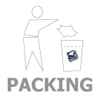The ministry of Shred recognises the need to safeguard our forests and protect our trees. It has always been our policy to fully recycle all the cardboard, paper and plastics with a completed audit trail, many of the materials we recycle will be turned back into usable products.
Paper recycling is the process of recovering waste paper and remaking it into new paper products. There are three categories of paper that can be used as feed-stocks for making recycled paper: mill broke, pre-consumer waste, and post-consumer waste. Mill broke is paper trimmings and other paper scrap from the manufacture of paper, and is recycled internally in a Paper Mill. Pre-consumer waste is material which left the paper mill, which has been discarded before it was ready for consumer use. Post-consumer waste is material discarded after consumer use, such as old magazines, old newspapers, office waste, old telephone directories, and residential mixed paper. Paper suitable for recycling is called “scrap paper”.
By seamlessly linking with our sister company Elsa Recycling Group we ensure that your destroyed documents are recycled back into paper products. In fact we save the equivalent of 14 trees for every ton of paper we recycle!
Today, 90% of paper pulp is made of wood. Paper production accounts for about 35% of felled trees and represents 1.2% of the world’s total economic output.Recycling one ton of newsprint saves about 1 ton of wood while recycling 1 ton of printing or copier paper saves slightly more than 2 tons of wood. This is because kraft pulping requires twice as much wood since it removes lignin to produce higher quality fibres than mechanical pulping processes.
Paper recycling is the process of recovering waste paper and remaking it into new paper products. There are three categories of paper that can be used as feed-stocks for making recycled paper: mill broke, pre-consumer waste, and post-consumer waste. Mill broke is paper trimmings and other paper scrap from the manufacture of paper, and is recycled internally in a Paper Mill. Pre-consumer waste is material which left the paper mill, which has been discarded before it was ready for consumer use. Post-consumer waste is material discarded after consumer use, such as old magazines, old newspapers, office waste, old telephone directories, and residential mixed paper. Paper suitable for recycling is called “scrap paper”.
By seamlessly linking with our sister company Elsa Recycling Group we ensure that your destroyed documents are recycled back into paper products. In fact we save the equivalent of 14 trees for every ton of paper we recycle!
Today, 90% of paper pulp is made of wood. Paper production accounts for about 35% of felled trees and represents 1.2% of the world’s total economic output.Recycling one ton of newsprint saves about 1 ton of wood while recycling 1 ton of printing or copier paper saves slightly more than 2 tons of wood. This is because kraft pulping requires twice as much wood since it removes lignin to produce higher quality fibres than mechanical pulping processes.








